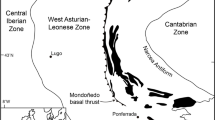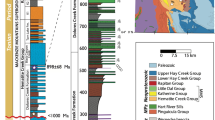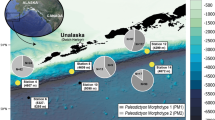Abstract
Microscopic animals that live among and between sediment grains (meiobenthic metazoans) are key constituents of modern aquatic ecosystems, but are effectively absent from the fossil record. We describe an assemblage of microscopic fossil loriciferans (Ecdysozoa, Loricifera) from the late Cambrian Deadwood Formation of western Canada. The fossils share a characteristic head structure and minute adult body size (~300 μm) with modern loriciferans, indicating the early evolution and subsequent conservation of an obligate, permanently meiobenthic lifestyle. The unsuspected fossilization potential of such small animals in marine mudstones offers a new search image for the earliest ecdysozoans and other animals, although the anatomical complexity of loriciferans points to their evolutionary miniaturization from a larger-bodied ancestor. The invasion of animals into ecospace that was previously monopolized by protists will have contributed considerably to the revolutionary geobiological feedbacks of the Proterozoic/Phanerozoic transition.
This is a preview of subscription content, access via your institution
Access options
Access Nature and 54 other Nature Portfolio journals
Get Nature+, our best-value online-access subscription
$29.99 / 30 days
cancel any time
Subscribe to this journal
Receive 12 digital issues and online access to articles
$119.00 per year
only $9.92 per issue
Buy this article
- Purchase on Springer Link
- Instant access to full article PDF
Prices may be subject to local taxes which are calculated during checkout


Similar content being viewed by others
References
Giere, O. Meiobenthology—The Microscopic Motile Fauna of Aquatic Sediments (Springer, 2009).
Laumer, C. E. et al. Spiralian phylogeny informs the evolution of microscopic lineages. Curr. Biol. 25, 2000–2006 (2015).
Struck, T. H. et al. The evolution of annelids reveals two adaptive routes to the interstitial realm. Curr. Biol. 25, 1993–1999 (2015).
Erwin, D. H. et al. The Cambrian conundrum: early divergence and later ecological success in the early history of animals. Science 334, 1091–1097 (2011).
Rota-Stabelli, O., Daley, A. C. & Pisani, D. Molecular timetrees reveal a Cambrian colonization of land and a new scenario for ecdysozoan evolution. Curr. Biol. 23, 392–398 (2013).
Fortey, R. A., Briggs, D. E. G. & Wills, M. A. The Cambrian evolutionary ‘explosion’: decoupling cladogenesis from morphological disparity. Biol. J. Linn. Soc. 57, 13–33 (1996).
Butterfield, N. J. & Harvey, T. H. P. Small carbonaceous fossils (SCFs): a new measure of early Paleozoic paleobiology. Geology 40, 71–74 (2012).
Kristensen, R. M. Loricifera, a new phylum with Aschelminthes characters from the meiobenthos. Z. Zool. Syst. Evol. 21, 163–180 (1983).
Neves, R. C., Reichert, H., Sørensen, M. V. & Kristensen, R. M. Systematics of phylum Loricifera: identification keys of families, genera and species. Zool. Anz. 265, 141–170 (2016).
Gad, G. Giant Higgins-larvae with paedogenetic reproduction from the deep sea of the Angola Basin—evidence for a new life cycle and for abyssal gigantism in Loricifera? Org. Divers. Evol. 5, 59–75 (2005).
Wills, M. A., Gerber, S., Ruta, M. & Hughes, M. The disparity of priapulid, archaeopriapulid and palaeoscolecid worms in the light of new data. J. Evol. Biol. 25, 2056–2076 (2012).
Hejnol, A. & Lowe, C. J. Embracing the comparative approach: how robust phylogenies and broader developmental sampling impacts the understanding of nervous system evolution. Phil. Trans. R. Soc. B 370, 20150045 (2015).
Schmidt-Rhaesa, A. in Handbook of Zoology: Nematomorpha, Priapulida, Kinorhyncha, Loricifera Vol. 1 (ed. Schmidt-Rhaesa, A. ) 147–180 (De Gruyter, 2013).
Sørensen, M. V. et al. New data from an enigmatic phylum: evidence from molecular sequence data supports a sister-group relationship between Loricifera and Nematomorpha. J. Zool. Syst. Evol. Res. 46, 231–239 (2008).
Yamasaki, H., Fujimoto, S. & Miyazaki, K. Phylogenetic position of Loricifera inferred from nearly complete 18S and 28S rRNA gene sequences. Zool. Lett. 1, 1–9 (2015).
Park, J. K., Rho, H. S., Kristensen, R. M., Kim, W. & Giribet, G. First molecular data on the phylum Loricifera: an investigation into the phylogeny of Ecdysozoa with emphasis on the positions of Loricifera and Priapulida. Zool. Sci. 23, 943–954 (2006).
Peel, J. S., Stein, M. & Kristensen, R. M. Life cycle and morphology of a Cambrian stem-lineage loriciferan. PLoS ONE 8, e73583 (2013).
Huang, D., Chen, J. & Vannier, J. Discussion on the systematic position of the Early Cambrian priapulomorph worms. Chinese Sci. Bull. 51, 243–249 (2006).
Maas, A., Huang, D., Chen, J., Waloszek, D. & Braun, A. Maotianshan-Shale nemathelminthes—morphology, biology, and the phylogeny of Nemathelminthes. Palaeogeogr. Palaeoclimatol. Palaeoecol. 254, 288–306 (2007).
Maas, A., Waloszek, D., Haug, J. T. & Mìller, K. J. Loricate larvae (Scalidophora) from the Middle Cambrian of Australia. Mem. Assoc. Aust. Palaeont. 37, 281–302 (2009).
Kirsteuer, E. Notes on adult morphology and larval development of Tubiluchus corallicola (Priapulida), based on in vivo and scanning electron microscope examinations of specimens from Bermuda. Zool. Scr. 5, 239–255 (1976).
Warwick, R. M. Are loriciferans paedomorphic (progenetic) priapulids? Vie Milieu 50, 191–193 (2000).
Hanken, J. & Wake, D. B. Miniaturization of body size: organismal consequences and evolutionary significance. Annu. Rev. Ecol. Syst. 24, 501–519 (1993).
Neves, R. C. et al. A complete three-dimensional reconstruction of the myoanatomy of Loricifera: comparative morphology of an adult and a Higgins larva stage. Front. Zool. 10, 19 (2013).
Rundell, R. J. & Leander, B. S. Masters of miniaturization: convergent evolution among interstitial eukaryotes. Bioessays 32, 430–437 (2010).
Budd, G. E. & Jensen, S. A critical reappraisal of the fossil record of the bilaterian phyla. Biol. Rev. 75, 253–295 (2000).
Webster, B. L. et al. Mitogenomics and phylogenomics reveal priapulid worms as extant models of the ancestral Ecdysozoan. Evol. Dev. 8, 502–510 (2006).
Smith, M. R., Harvey, T. H. P. & Butterfield, N. J. The macro- and microfossil record of the Cambrian priapulid Ottoia . Palaeontology 58, 705–721 (2015).
Warwick, R. M. Meiobenthos and macrobenthos are discrete entities and not artefacts of sampling a size continuum: comment on Bett (2013). Mar. Ecol. Prog. Ser. 505, 295–298 (2014).
Mìller, K. J., Walossek, D. & Zakharov, A. ‘Orsten’ type phosphatized soft-integument preservation and a new record from the Middle Cambrian Kuonamka Formation in Siberia. Neues Jb. Geol. Palaeontol. Abh. 197, 101–118 (1995).
Walossek, D. & Mìller, K. J. in Arthropod Fossils and Phylogeny (ed. Edgecombe, G. D. ) 185–231 (Columbia Univ. Press, 1998).
Dong, X.-P., Donoghue, P. C. J., Cheng, H. & Liu, J.-B. Fossil embryos from the Middle and Late Cambrian period of Hunan, south China. Nature 427, 237–240 (2004).
Zhang, H. et al. Armored kinorhynch-like scalidophoran animals from the Early Cambrian. Sci. Rep. 5, 16521 (2015).
Dong, X.-P. et al. Developmental biology of the Early Cambrian cnidarian Olivooides . Palaeontology 59, 387–407 (2016).
Cullen, D. J. Bioturbation of superficial marine sediments by interstitial meiobenthos. Nature 242, 323–324 (1973).
Gerlach, S. A. Food-chain relationships in subtidal silty sand marine sediments and the role of meiofauna in stimulating bacterial productivity. Oecologia 33, 55–69 (1978).
Aller, R. C. & Aller, J. Y. Meiofauna and solute transport in marine muds. Limnol. Oceanogr. 37, 1018–1033 (1992).
Coull, B. C. Role of meiofauna in estuarine soft-bottom habitats. Aust. J. Ecol. 24, 327–343 (1999).
Pike, J., Bernhard, J. M., Moreton, S. G. & Butler, I. B. Microbioirrigation of marine sediments in dysoxic environments: implications for early sediment fabric formation and diagenetic processes. Geology 29, 923–926 (2001).
Porter, S. M. Tiny vampires in ancient seas: evidence for predation via perforation in fossils from the 780–740 million-year-old Chuar Group, Grand Canyon, USA. Proc. R. Soc. B 283, 20160221 (2016).
Smith, F. A. et al. Body size evolution across the Geozoic. Annu. Rev. Earth Planet. Sci. 44, 523–553 (2016).
Brown, J. H., Marquet, P. A. & Taper, M. L. Evolution of body size: consequences of an energetic definition of fitness. Am. Nat. 142, 573–584 (1993).
Mángano, M. G. & Buatois, L. A. Decoupling of body-plan diversification and ecological structuring during the Ediacaran–Cambrian transition: evolutionary and geobiological feedbacks. Proc. R. Soc. B 281, 20140038 (2014).
Tarhan, L. G., Planavsky, N. J., Laumer, C. E., Stolz, J. F. & Reid, R. P. Microbial mat controls on infaunal abundance and diversity in modern marine microbialites. Geobiology 11, 485–497 (2013).
Danovaro, R. et al. The challenge of proving the existence of metazoan life in permanently anoxic deep-sea sediments. BMC Biol. 14, 43 (2016).
Pawlowska, M. M., Butterfield, N. J. & Brocks, J. J. Lipid taphonomy in the Proterozoic and the effect of microbial mats on biomarker preservation. Geology 41, 103–106 (2012).
Löhr, S. C. & Kennedy, M. J. Micro-trace fossils reveal pervasive reworking of Pliocene sapropels by low-oxygen-adapted benthic meiofauna. Nat. Commun. 6, 6589 (2015).
Harvey, T. H. P. & Butterfield, N. J. Data from: Exceptionally preserved Cambrian loriciferans and the early animal invasion of the meiobenthos. figshare http://dx.doi.org/10.6084/m9.figshare.4036104 (2016).
Heiner, I. & Kristensen, R. M. Two new species of the genus Pliciloricus (Loricifera, Pliciloricidae) from the Faroe Bank, North Atlantic. Zool. Anz. 243, 121–138 (2005).
Acknowledgements
We thank staff at the Geological Subsurface Laboratory, Regina, Saskatchewan, and M. Vélez, University of Regina, for help with core sampling. We thank geoLOGIC for generous access to subsurface data. This work was supported by Natural Environment Research Council Grant NE/H009914/1.
Author information
Authors and Affiliations
Contributions
T.H.P.H. and N.J.B. designed and performed the research and wrote the paper.
Corresponding author
Ethics declarations
Competing interests
The authors declare no competing financial interests.
Supplementary information
Supplementary information
Supplementary Figures 1–3 and Supplementary Table 1. (PDF 4071 kb)
Rights and permissions
About this article
Cite this article
Harvey, T., Butterfield, N. Exceptionally preserved Cambrian loriciferans and the early animal invasion of the meiobenthos. Nat Ecol Evol 1, 0022 (2017). https://doi.org/10.1038/s41559-016-0022
Received:
Accepted:
Published:
DOI: https://doi.org/10.1038/s41559-016-0022
This article is cited by
-
A Middle Ordovician Burgess Shale-type fauna from Castle Bank, Wales (UK)
Nature Ecology & Evolution (2023)
-
Geometric morphometrics of macro- and meiofaunal priapulid pharyngeal teeth provides a proxy for studying Cambrian “tooth taxa”
Zoomorphology (2023)
-
Tube-dwelling in early animals exemplified by Cambrian scalidophoran worms
BMC Biology (2021)
-
A new genus and species of Loricifera (Nanaloricida: Pliciloricidae) from the deep waters of Japan
Marine Biodiversity (2020)
-
First report of Loricifera from the North East Pacific Region, with the description of two new species
Marine Biodiversity (2019)



